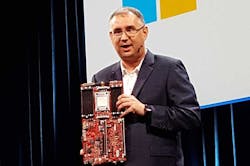SANTA CLARA, Calif. – Has the big moment finally arrived for ARM servers? Microsoft has given a major boost to the nascent market for servers powered by low-energy processors from ARM, which are widely used in mobile devices like iPhones and iPads.
At last week’s Open Compute Summit, Microsoft confirmed that it is test-driving ARM cloud servers from Qualcomm and Cavium in its data centers – but only for internal workloads and not its public Windows Azure cloud.
“We’ve been running evaluations of their hardware on cloud workloads in our data centers,” said Leendert Van Doorn, a Distinguished Engineer at Windows Azure. “We run these in parallel with our production servers, and the performance is compelling. These are not the old ARM servers you knew.”
The vendors, who until now had been working behind the scenes with Microsoft, said the public announcement will provide much-needed momentum for ARM servers.
“The Microsoft endorsement is a defining moment in ARM server history,” said Syed Ali, the President and CEO of Cavium. “We think this will significantly accelerate others accepting these servers. This will start a tsunami effect in the whole ecosystem.”
Long Path to the Data Center
ARM technology has had a winding path to the data center. Back in 2010, there were a half dozen companies working to develop ARM servers in a bid to help data centers slash their power bills. Chief among them was Calxeda, which raised $103 million in venture capital, but went out of business in 2013. In the past several years, ARM technology has slowly rebuilt momentum with servers from Cavium, Qualcomm, AMD and Applied Micro, but none have made meaningful inroads into Intel’s dominance in the data center.
Microsoft could help change that. But before ARM fans get too giddy, it’s important to note the caveats with Microsoft’s adoption.
“This is all for internal use,” said Van Doorn. “We don’t see any enterprise demand for ARM servers.” He also said they were not considering ARM for use powering virtual machine workloads.
The Microsoft collaboration with Cavium runs on its flagship 2nd generation 64-bit ThunderX2 ARMv8-A server processor SoCs. Here’s a look at a prototype at the Microsoft booth at the Open Compute Summit. (Photo: Rich Miller)
Even without enterprise adoption, Microsoft’s embrace of ARM servers could stimulate demand. Microsoft runs hundreds of applications on its internal cloud infrastructure, at a scale that creates the potential for volume sales that could support a healthy ecosystem – which in turn could support the evolution of more competitive data center offerings based on ARM.
“There is more opportunity now to increase dynamic competition in the server market,” said Casey Axe of ARM Holdings, the British tech company, which was acquired last year by Softbank. “And I believe it will ultimately be regarded as the point when the data center began a fundamental transformation.”
Intel Remains Dominant
Intel’s x86 processors remain dominant in the data center, with an estimated server market share north of 95 percent. The rise of machine learning, bitcoin mining and other specialized types of high performance computing (HPC) has boosted interest in new chips that can be tuned to workloads, including GPUs, FPGAs and ASICs. Hyperscale cloud providers have experienced rapid growth, accounting for most of the growth in server sales, while enterprise IT spending has stagnated.
This has laid the groundwork for ARM to get another look. There are two developments that laid the groundwork for Microsoft’s interest in ARM. The first is that the technology has improved.
“ARM has made a lot of noise about servers,” noted Van Doorn. “We first did this experiment about 10 years ago. The first generation of servers, while interesting, did not meet our performance needs. What we are seeing today is ARM servers with lots of threads and cores, and lots of connectivity options. Now the world is different.”
“If you look at the first generation of ARM servers, they had limited application,” said Cavium CEO Ali. “We believe the new servers will address a fairly substantial portion of the market.”
Addressing the Software Issue
The other issue has been software, as code written to run on x86 processors must be modified to work on an ARM platform. That was a particular barrier for enterprises with many legacy applications. It’s a simpler matter for Microsoft cloud.
“One of the biggest hurdles to enable ARM servers is the software,” said Van Doorn. “Rather than trying to port every one of our many software components, we looked at where ARM servers are applicable and where they provide value to us. We found that they provide the most value for our cloud services, specifically our internal cloud applications such as search and indexing, storage, databases, big data and machine learning. These workloads all benefit from high-throughput computing.
“To enable these cloud services, we’ve ported a version of Windows Server, for our internal use only, to run on ARM architecture,” he added. “We have ported language runtime systems and middleware components, and we have ported and evaluated applications, often running these workloads side-by-side with production workloads.”
The Microsoft collaboration with Qualcomm features a Centriq 2400 ARM server processor, a new 10nm, 48-core server processor. Here’s a look at a prototype at the Microsoft booth at the Open Compute Summit. (Photo: Rich Miller)
ARM Sees ‘Far Reaching Impications’
While Microsoft was clear that the applications for its processors were fairly specific for now, ARM’s Axe believes the comments from Van Doorn will boost its prospects.
“While his statements are measured, they will have far-reaching implications, setting the tone for the future of the server market,” said Axe. “For ARM, this point has been a result of many years of hard work. After succeeding in mobile and seeing our technology move into a vast swathe of other sectors we recognized the need to also get involved in data infrastructure. Now we are building our investments in next-generation network infrastructure and server technologies.”
ARM’s impact in power management for mobile devices has always made them an intriguing play for low-power servers.
“There is a structural shift in data center process technology,” said Ram Peddibhotla, VP and Product Manager of Datacenter Technologies for Qualcomm. “It’s driven by mobile processors, which puts Qualcomm in an interesting position. We’re bringing the world’s first 10 nm processors to market.”
Microsoft made clear that it doesn’t view its work on ARM servers as a short-term experiment, but hope ARM processors that will eventually be appropriate for general computing as well as cloud.
“We’re driving innovation with ARM64 servers in our data centers,” said Van Doorn. “We are working with Qualcomm and Cavium on optimizing for their components. These are long term relationships.”






